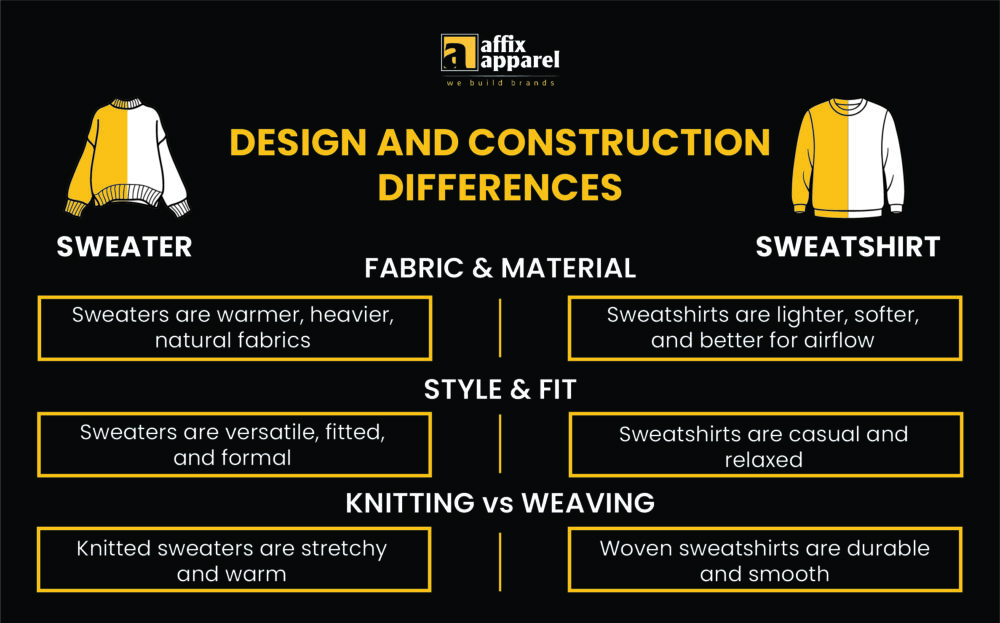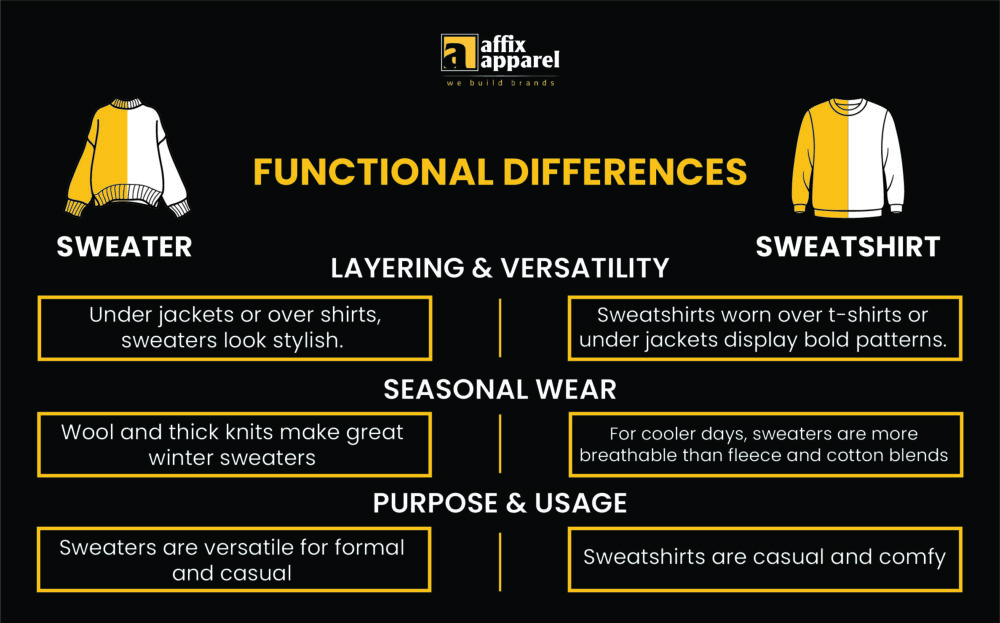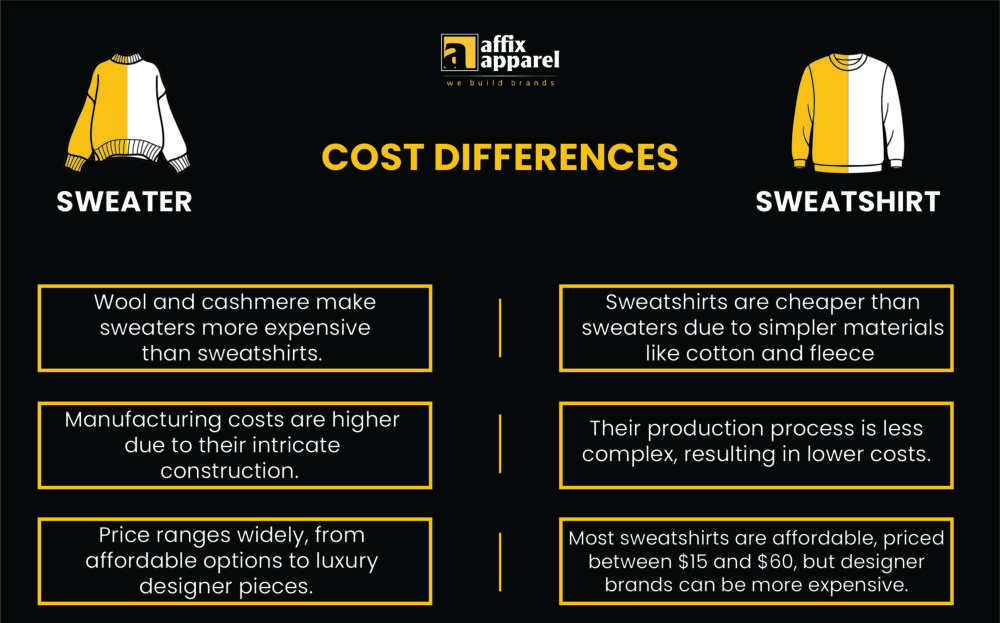Have you ever pondered the subtle yet significant differences between a sweater and a sweatshirt? This topic frequently arises in the fashion world, and understanding this distinction could have a profound impact on your clothing brand. While both garments are designed for comfort and suited for colder climates, they differ significantly in terms of style, functionality, and intended use. In this blog post, we'll explore the key attributes of sweaters versus sweatshirts to help you decide which is best suited for your next design project! Though both sweaters and sweatshirts excel at keeping you warm, their origins trace back to cotton practice jerseys used in sports. The term "sweat" in their names reflects their shared history, which sometimes causes confusion. Recognizing the fundamental difference between these two garments is critical for any fashion business looking to stand out in the market. A sweatshirt is a cozy, informal piece of clothing often associated with athletic wear. Typically made from fleece or cotton blends, sweatshirts are crafted to be comfortable and easy to wear. Fleece is renowned for its soft insulating properties, making it ideal for cold weather, while cotton blends offer a balance of comfort and breathability. For those curious about whether a hoodie qualifies as a sweatshirt, the answer is yes—hoodies are simply sweatshirts with added features like hoods and front pockets. Crewnecks, on the other hand, feature round necklines without collars. These styles are popular for their relaxed fits and are ideal for casual settings, workouts, or simply lounging around. Learn more about: Choosing the Right Hoodie Fabric Here's where things get interesting. A sweater is a piece of knitted clothing primarily designed to keep you warm. Made from wool, cotton, or synthetic materials, sweaters are highly versatile and come in a variety of designs. Wool remains the classic choice for its superior insulation, while cotton offers a lighter, more breathable alternative. Synthetic fibers enhance durability and flexibility. Are pullovers and sweaters the same thing? This question often confuses people. Common sweater styles include cardigans, which have front openings and button closures, and pullovers, which are slipped over the head. Sweaters come in varying weights, from lightweight to chunky, allowing for layering in both casual and formal contexts. Learn more about: Exploring the World of Cardigans Understanding the design and construction differences between sweaters and sweatshirts is vital for any clothing brand. These distinctions affect not only the appearance and functionality of the garments but also their appeal to consumers. Every detail—from the materials used to the construction techniques and resulting style and fit—is crucial in defining these beloved wardrobe staples. One of the most apparent differences between sweaters and sweatshirts lies in their materials. Sweaters are typically made from natural fibers like wool and cotton, or synthetic materials such as acrylic. These fabrics provide sweaters with a soft, snug feel, making them perfect for cold weather. Sweater fabrics are usually thicker and more robust, offering excellent insulation. In contrast, sweatshirts are usually crafted from cotton or fleece blends. These materials are lighter and softer, creating a cozy, laid-back vibe that makes them so popular. Sweatshirts are designed to allow airflow and wick moisture, making them suitable for both leisure and sport. Sweaters and sweatshirts vary in style, fit, and intended use. Sweaters often come in tailored fits, available in styles like cardigans, pullovers, and turtlenecks, allowing them to transition seamlessly between casual and formal settings. They can be layered over shirts for a polished look or worn alone for comfort and warmth. Meanwhile, sweatshirts typically feature a looser, more relaxed fit, often seen in styles like hoodies and crewnecks. These are perfect for casual outings, sports, or simply lounging at home. When selecting garments for your collection, consider the specific fashion demands and events, as each style and fit serves a unique purpose. The methods used to create sweaters and sweatshirts, such as knitting and weaving, significantly impact their texture and appearance. Most sweaters are made through knitting, which involves interlocking loops of yarn to form a flexible, stretchy material. This technique produces varied textures and patterns, making sweaters warm, stylish, and versatile for different occasions. On the other hand, sweatshirts are produced via weaving, where threads cross at right angles to create a fabric that is firmer and more structured. This method results in a smoother, denser texture, ideal for garments focused on comfort and longevity. Choosing between knitting or weaving a garment will influence its flexibility, warmth, and overall aesthetic. Each piece of clothing has unique advantages and serves distinct purposes, from seasonal wear to adaptability and specific usage scenarios. This section will delve into the functional differences between sweaters and sweatshirts, providing insights into their optimal uses in various situations. One of the primary benefits of both sweaters and sweatshirts is their ability to layer and complement other outfits. Sweaters can be worn under jackets or over shirts to create a cohesive, stylish look suitable for both casual and semi-formal occasions. Their diverse designs, such as cardigans and pullovers, make them easy to pair with other clothing items. Sweatshirts, celebrated for their relaxed and cozy nature, are ideal for wearing over t-shirts or under jackets. They are perfect for a casual, informal appearance and can make a bold statement when adorned with eye-catching designs or logos. Learn more about: Understanding the Difference Between Coats and Jackets When it comes to seasonal clothing, sweaters and sweatshirts shine in different ways. Compared to sweatshirts, sweaters are better suited for colder seasons due to their materials, such as wool or thick knits, which provide excellent insulation. They are ideal for staying warm during autumn and winter. Conversely, sweatshirts, often made from fleece or cotton blends, are more versatile and appropriate for various climates. While they offer warmth, they are lighter and more breathable, making them suitable for cooler spring and autumn days, as well as chilly summer nights. People often wonder, "Are sweaters and sweatshirts the same?" Despite their similarities, these garments serve different functions and are suited for different occasions. Sweaters are incredibly versatile, effortlessly transitioning between casual and formal events. They are practical and can be worn for work, social gatherings, or casual outings, making them a staple in many wardrobes. Their intricate knitting gives them an elegant touch, making them suitable for everyday wear and formal occasions alike. On the other hand, sweatshirts are primarily associated with casual and sporty attire. They are perfect for relaxation, running errands, or engaging in physical activities. Designed with a loose fit and comfort in mind, sweatshirts are ideal for casual wear and athleisure. Several factors, including materials, brand positioning, and manufacturing costs, contribute to the price disparities between sweaters and sweatshirts. Sweaters tend to be more expensive than sweatshirts in comparative terms due to the materials and craftsmanship involved. High-end sweaters are often made from premium fabrics like wool, cashmere, or merino, which are more costly than the standard cotton or polyester blends used in sweatshirts. The production of sweaters involves more intricate processes and labor, driving up the manufacturing expenses. Additionally, sweaters frequently incorporate detailed designs, patterns, and embellishments, which can further increase their price. As a result, sweaters can range widely in price, from budget-friendly options starting at $10-$50 to luxury pieces that can cost several hundred dollars or more. Sweatshirts are generally more affordable than sweaters due to their simpler materials and construction. Most sweatshirts are made from cotton, fleece, or synthetic blends, which are more economical compared to the wool or cashmere used in many sweaters. The production process for sweatshirts is typically simpler and less expensive. Furthermore, sweatshirts often feature a more relaxed and functional design, reducing production costs. While designer or branded sweatshirts may command higher prices, most sweatshirts fall within the $15-$60 range, making them accessible to the average consumer. However, exclusive or premium sweatshirts from well-known brands can exceed $100 in price. Knowing how to properly care for your sweatshirts and sweaters is essential to maintaining their appearance and comfort over time. Let’s explore the care instructions for both. Proper maintenance is crucial to ensure your sweaters retain their quality and longevity. Sweaters made from delicate fabrics like wool or cashmere require special attention. It’s best to hand-wash them in cold water using a mild detergent to prevent shrinking and preserve the softness of the fabric. Avoid wringing out excess water; instead, gently press the moisture out with a towel and lay the sweater flat to dry. If machine washing is necessary, use a gentle cycle and place the sweater in a mesh laundry bag. To avoid stretching, fold sweaters and store them in a cool, dry place. Cedar balls or lavender sachets can help deter moths. Regular ventilation and the use of a fabric shaver to remove pills will keep your sweaters smelling fresh and looking good for years to come. Sweatshirts are relatively easy to care for compared to sweaters but still require proper handling. To maintain their quality, wash them in a machine with cold water and a mild detergent, turning them inside out to protect prints and colors. Avoid using bleach to prevent damage and discoloration. Allow the sweatshirt to air dry flat or hang it to dry, or use a low-heat setting in the dryer. Store folded sweatshirts in a cool, dry place away from direct sunlight. Use tissue paper between folds to protect delicate prints. A fabric shaver can be used to remove pills and keep your sweatshirts looking vibrant. Following these guidelines will help extend the life and comfort of your sweatshirts. Understanding the differences between sweaters and sweatshirts is essential when building a successful clothing brand. Sweaters offer warmth, versatility, and style, making them suitable for a variety of occasions. Sweatshirts, on the other hand, prioritize comfort and casual wear. Consider your target audience, brand goals, and desired aesthetic when incorporating these garments into your collection. By recognizing the unique features of each, you can make informed decisions that align with your brand’s vision and customer preferences. When planning your next apparel line, think about whether you want your customers to feel relaxed and active or elegant and sophisticated. Reach out to Affix Apparel for top-tier custom clothing manufacturing services to bring your ideas to life!
Bath
towel is a type of towel specifically designed for drying the body
after bathing or showering. It is typically larger than other types of
towels, with a standard size of around 27 inches by 52 inches. Bath
towels are made from a variety of materials, including cotton, bamboo,
and microfiber. They can be plain or patterned, and come in a range of
colors to match any bathroom decor. Some bath towels may also feature
decorative borders or embroidery. Bath towels are an essential item in
any bathroom, providing a soft and absorbent way to dry off after
bathing.
Bath Towel,Microfibre Bath Towel,Bath Baby Towels,Hotel Hand Towel,microfiber bath towel,cotton bath towels,hotel towels,cotton hotel towels suzhou bangneng textile co.,ltd , https://www.bangnengtowel.comSweatshirt vs Sweater: The Core Distinction
What Is a Sweatshirt?

Defining the Sweater

Design and Construction Variations

Fabric and Material Disparities
Style and Fit
Weaving vs Knitting
Functional Differences

Layering and Versatility
Seasonal Wear
Purpose and Usage
Cost Differences

Price of Sweaters
Price of Sweatshirts
Care Instructions
Care Instructions for Sweaters
Care Instructions for Sweatshirts

Planning Your Next Clothing Line: Sweaters vs Sweatshirts